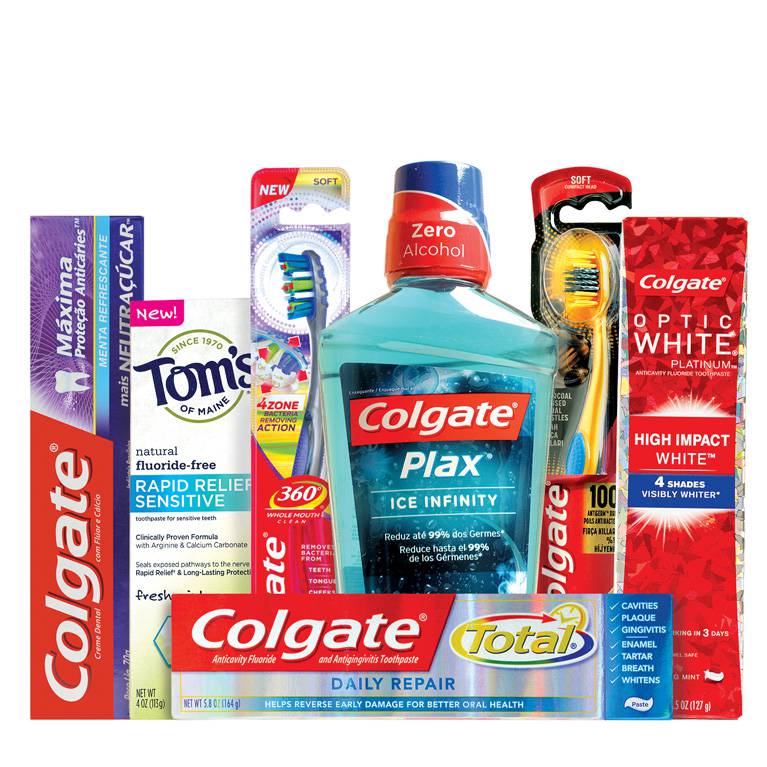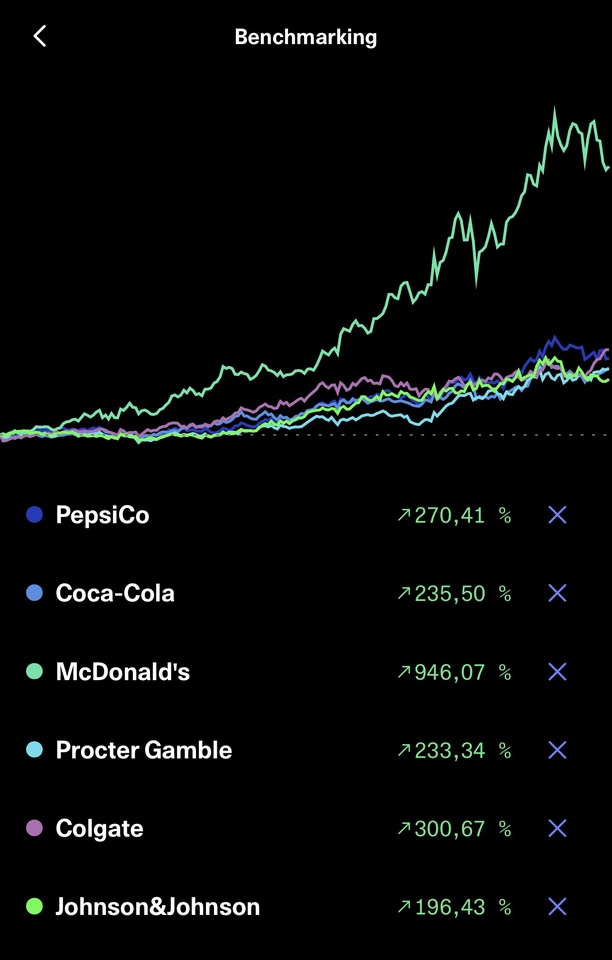I got a sample pack of toothpaste from the sales clerk at Rossmann out of pity 😀

Colgate
Price
Discussion sur CL
Postes
27$CL (-0,56 %) | Colgate-Palmolive Q3'24 Earnings Highlights
🔹 Revenue: $5.03B (Est. $5.01B) 🟢; UP +2.4% YoY
🔹 Base Business EPS: $0.91 (Est. $0.88) 🟢; UP +6% YoY
Narrowed FY24 Guidance:
🔹 Net Sales Growth: 3%-5% (Prev. 2%-5%)
🔹 Organic Sales Growth: 7%-8% (Prev. 6%-8%)
🔹 Non-GAAP EPS Growth: 10%-11% (Prev. 8%-11%)
Key Performance Metrics:
🔹 Organic Sales Growth: +6.8%
🔹 Gross Profit Margin (GAAP): 61.1% (vs. 58.5% YoY)
🔹 Base Business Gross Profit Margin: 61.3%; UP +270 bps YoY
Divisional Organic sales :
🔸 North America: -1.9%
🔸 Latin America: +14.2%
🔸 Europe: +6.3%
🔸 Asia Pacific: +6.1%
🔸 Hill's Pet Nutrition: +6.5%
COLGATE-PALMOLIVE Q3 2024 $CL (-0,56 %)
Financial Performance:
Colgate-Palmolive reported sales growth of 2.4% in the third quarter of 2024, while organic sales increased by 6.8%. This growth was driven by a balanced increase in both volume and pricing across all businesses, marking the second consecutive quarter of positive volume growth for the company.
Balance sheet analysis:
As of September 30, 2024, Colgate-Palmolive's total assets were $16.774 million, with total liabilities of $15.938 million. Shareholders' equity amounted to USD 435 million and shows a decrease compared to previous periods.
Income statement:
The company reported a 270 basis point increase in gross profit margin on a core basis, marking the sixth consecutive quarter of gross margin expansion. Operating profit for the quarter increased 4% year-over-year to $1.065 million.
Cash Flow Analysis:
Colgate-Palmolive generated record cash flow from operations with a net amount of $2.838 million for the first nine months of 2024. Free cash flow before dividends increased to $2.461 million, compared to $2.101 million in the same period last year.
Key figures and profitability:
Return on capital employed increased by over 600 basis points to 34.7%. The company also maintained a strong gross profit margin and increased advertising spend by 16% in the quarter.
Segment Analysis:
- North America: Recorded a -2.1% decline in net sales, but with a 1.2% increase in organic sales volume.
- Latin America: Achieved significant organic sales growth of 14.2 %.
- Europe: Net sales rose by 8.0%, while organic sales increased by 6.3%.
- Asia-Pacific and Africa/Eurasia: Also reported positive developments in net sales and organic sales.
Competitive analysis:
Colgate-Palmolive maintained its leading position in the global toothpaste market with a market share of 41.0% in 2024 year to date. Through increased advertising and innovation, the focus remains on market penetration and strengthening brand awareness.
Forecasts and management comments:
The company has updated its forecasts for 2024 and expects sales growth of 3% to 5% and organic sales growth of 7% to 8%. Both the gross profit margin and investment in advertising are expected to increase and double-digit growth in GAAP earnings per share is anticipated.
Risks and opportunities:
Challenges exist due to moderate increases in raw material and packaging costs, mainly due to exchange rate effects. However, strong cost-saving initiatives should largely offset these burdens.
Summary and strategic implications:
Colgate-Palmolive's solid performance in Q3 2024, with robust organic sales growth and improved profit margins, confirms the effectiveness of its strategic actions. The focus on innovation, brand building and operational efficiency positions the company well for sustainable growth. Nevertheless, it must successfully overcome external challenges such as exchange rate and raw material cost increases in order to maintain its competitiveness and achieve its updated financial targets. Hot for me to keep watching and hope that the share price falls at some point.
Positive highlights
- Strong organic sales growth: Colgate-Palmolive delivered strong organic sales growth of 6.8% in the third quarter of 2024, driven by balanced volume and price increases across all business units
- Gross profit margin expansion: Core gross profit margin increased by 270 basis points, marking the sixth consecutive quarter of margin improvement
- Market leadership: Colgate-Palmolive defended its leading position in the global toothpaste market with a market share of 41.6% year to date.
- Strong operating cash flow: The company reported record cash flow from operations for the current year, generating a net amount of USD 2,838 million in the first nine months of 2024.
- Return on capital employed improved: Return on capital employed increased by more than 600 basis points to 34.7%, indicating increased operational efficiency.
Negative highlights
- Exchange rate effects: Sales growth was negatively impacted by mid-single-digit exchange rate effects, which weighed on the growth forecast for the full year.
- Decline in sales in North America: There was a decline in sales of -2.1% in North America, indicating challenges in this key market.
- Increased advertising costs: Advertising spend increased by 16%, which supports brand strength but also represents a significant increase in costs.
- Decrease in shareholders' equity: Shareholders' equity fell to USD 435 million, below previous periods, which could indicate potential financial stress or strategic investments that have not yet yielded returns.
- Pressure from raw material costs: The company is facing moderate increases in raw material and packaging costs, which could put pressure on margins if these costs are not managed effectively.

Over the last few days I have been busy sorting out shares again and have now reduced my positions from 77 to 65.
------------------------------------------------------------------------------------------------
True to the motto: "With a heavy heart I am selling my rusty used car", the following positions have left my portfolio these days.
$GME (-2,61 %) with -6.22% 🤓
$MO (+0,93 %) +6,78%
$SYK (-0,57 %) +0,32%
$KDP (-0,13 %) +14,62%
$CL (-0,56 %) +12,32% 😢
$ECL (-1,2 %) +5,22%
-------------------------------------------------------------------------------------------------
However, two should follow immediately. 😜 Yes, the goal is actually to reduce stocks and not add any new ones. But these two simply fit perfectly into my growth strategy, namely $WALMEX* (+0,74 %) & $MELI (+0,1 %) In addition, -6 + 2 still makes -4, which is a WIN WIN situation.
-------------------------------------------------------------------------------------------------
But unfortunately I can't get into the 2 stocks. With $MELI (+0,1 %) I want to wait, as it is very highly valued and I see a certain downside potential in the next few weeks. With $WALMEX* (+0,74 %) I have a limit order at €2.59, but I can't get in. Although the price has already fallen below it yesterday and today. The problem is that Trade Republic has a spread of 18-24 cents per Walmex share, i.e. almost 10% 😨
-------------------------------------------------------------------------------------------------
Good evening everyone,
The first steps have been taken. I sold the following shares today:
$KMB (+0,3 %) A weak underperformer that operates in a business sector with a poor stomach.
I simply don't see any significant growth opportunities here over the next few years. I'd rather put the money into my broadly diversified world ETF or other investments. I got out with just under +10 %.
$PAYX (+2,08 %) Out with around 6.5 % and the reasons for the sale are largely the same as for Kimberly-Clark.
$MSTR (-4,88 %) After the rapid rise of the last few weeks, this has become too risky for me. I got out after a short holding period with around 28%.
In addition, the correlation with Bitcoin is very strong. And I'd rather hold my own $BTC (+0,44 %) . From another perspective, if the value of the Bitcoin held is roughly half the market capitalization and you ignore the high level of debt, I still don't know where the other half of the market capitalization comes from.
The dividend aristocrat Procter & Gamble was actually also on the hit list for today $PG (-1,77 %) Ecolab $ECL (-1,2 %) and Colgate $CL (-0,56 %) . I'm still not 100% sure about these, hence the vote. I would like to take a closer look. I was particularly fascinated by the 12m chart for Colgate. It looks as if a child has drawn a straight line from bottom left to top right. It's similar with Ecolab, where they have made around 45% in twelve months with dividends. (With Colgate around 40 %)
What happens next? The portfolio will be further reduced/concentrated. The BDCs are high on the hit list $ARCC (-0,53 %)
$MAIN (-0,08 %)
$HTGC (-0,45 %)
REITs, on the other hand, can stay, as they currently have strong momentum and could benefit from falling interest rates. The only one I'm not quite sure about yet and would like to take a closer look at fundamentally when the opportunity arises is $STAG (-0,33 %)
Hey everyone,
I'm currently facing the challenge of reducing my portfolio from 77 to a maximum of 30 shares in order to get a better overview and focus my strategy. But I'm not sure how best to proceed.
Should I:
- Sell the stocks that have done badly as they are obviously not performing well?
- Or should I rather sell the ones that have performed best in order to take profits before things go downhill?
- Or simply sell the 40 smallest positions? But there are also many interesting stocks in there that might be worth expanding.
- Or simply sell everything that is heavily weighted in the MSCI World and thus reduce the cluster risk?
Perhaps there is a better approach? What do you look for when reducing your positions? Diversification, dividend yield, or simply the size of the individual positions in relation to the overall portfolio? I look forward to your opinions and tips!
Thanks in advance!
Every year you can offset losses from previous years against realized gains from the current year tax-free. Up to 20000 euros each year. But only within the same asset class. So shares with shares and ETFs with ETFs, but not one with the other.
This means that if, for example, you make a loss of 30,000 euros when you sell your shares, you can take profits of up to 20,000 euros from other shares tax-free this year and another 10,000 euros the following year.
The nice thing about this is that, according to the current legal situation, this loss carryforward continues from one year to the next. As long as the legal situation does not change, you can only start to offset your current losses against your later gains in 10 years' time.
You could therefore 'save' these shares and hope for better times. However, there is a good chance that it would be better to let the money 'work' somewhere else in the meantime.
However, there is one problem with this. Normally, your bank will do all the clearing automatically (you'll have to ask). But if you use a neobroker, there are differences. Brokers who are 'tax-simple' will also do this for you. Just like banks, they automatically pay your taxes on profits and should also handle loss carryforwards correctly.
However, if your broker is not 'tax-simple' then you should receive paperwork once a year that you have to keep yourself and settle with the tax office. You may also need / want to have a tax advisor for this.
To complicate things further:
With a tax advisor, you can do your tax return up to 3 years later. 'Savings foxes' might come up with the idea of not paying tax on their profits from this year until 3 years from now and hope to make a nice return on their currently untaxed profits for the next 3 years.
I think I will sell the following titles:
These stocks are very heavily represented in the MSCI World. This reduces cluster risk and frees up capital for speculative growth stocks.
-----------------------------------------------------
The REITs remain for the time being as they have positive momentum and will benefit strongly from future interest rate cuts.
------------------------------------------------------
Flying out as I don't understand the industry well enough.
$HIMS (-0,39 %) remains, on the other hand.
------------------------------------------------------
Defensive stocks are out, as no excess return is to be expected here.
--------------------------------------------------------
$AMD (-0,7 %) and $INTC (-4,02 %) These are my turnaround candidates, as soon as this is completed, they are out
--------------------------------------------------------
The following titles are also on the hit list:
-----------------------------------------------------------
What do the more experienced among you say? Are there any titles on my list that are worth keeping? Do you see any gross misjudgments? Do you have any suggestions for improvement?
Thanks in advance.
Hey everyone,
I'm currently facing the challenge of reducing my portfolio from 77 to a maximum of 30 shares in order to get a better overview and focus my strategy. But I'm not sure how best to proceed.
Should I:
- Sell the stocks that have done badly as they are obviously not performing well?
- Or should I rather sell the ones that have performed best in order to take profits before things go downhill?
- Or simply sell the 40 smallest positions? But there are also many interesting stocks in there that might be worth expanding.
- Or simply sell everything that is heavily weighted in the MSCI World and thus reduce the cluster risk?
Perhaps there is a better approach? What do you look for when reducing your positions? Diversification, dividend yield, or simply the size of the individual positions in relation to the overall portfolio? I look forward to your opinions and tips!
Thanks in advance!
The same applies to the healthcare sector. If you don't understand the established players, in what constellation do you understand those that are difficult to assess anyway? Defensive stocks are out ... because they are defensive? And AMD is not a "turnaround candidate" - you simply bought far too expensively.
All in all, it gives the impression that you don't really understand individual stocks, i.e. which stocks to buy why and how to value the companies in the first place. I also don't know if you're interested in learning, otherwise you should probably just stick to ETFs (I'm very reluctant to recommend that).
But what it shouldn't be, at least, is that you look at individual stocks as something where you pick the ones that tell a nice story in the hope that you're going to beat the market big time.
⚠️⚠️⚠️Breaking News⚠️⚠️⚠️
ATTENTION to all who have a deposit with Trade Republic, today more than 100 savings plans will be executed with me, the real offensive starts at 15.30 and can take up to 4 hours, as there may well be "massive" "failures" and "delays" during this time, I ask you to keep calm, take a deep breath and not to bombard Trade Republic customer support with inquiries. Thank you very much 😁
As far as the Ultimate Homer "ETF" is concerned, many new stocks were added in September 😁
In since September 2
🇺🇸Chipotle $CMG (-2,32 %)
🇺🇸Costco $COST (-0,78 %)
🇺🇸Domino's Pizza's $DPZ (-1,6 %)
🇺🇸Texas Roadhouse $TXRH (-1,16 %)
🇺🇸TransDigm $TDG (-1,35 %)
Newly launched today
🇺🇸Booz Allen Hamilton Holding
$BAH (-2,73 %)
🇺🇸Blackstone $BX (-0,29 %)
🇺🇸KKR & Co
$KKR (-0,79 %)
🇺🇸Vulcan Materials
$VMC (+0 %)
🇺🇸CSX $CSX (-0,79 %)
🇺🇸Carrier Global $CARR (-0,19 %)
🇺🇸Hilton Worldwide $HLT (-1,73 %)
🇺🇸Merck & Co $MRK (-1,78 %)
🇺🇸Moodys $MCO (+0,31 %)
🇺🇸Rollins $ROL (-1,01 %)
🇺🇸Toll Brothers $TOL (-1,62 %)
🇺🇸Watsco $WSO (-1,36 %)
🇺🇸Cardinal Health $CAH (-0,93 %)
🇺🇸Colgate Palmolive $CL (-0,56 %)
🇺🇸Emerson Electric $EMR (-1,56 %)
🇺🇸Nordson $NDSN (-1,38 %)
🇬🇧BAE Systems
$BA. (-2,19 %)
🇬🇧RELX
$REL (-1,61 %)
🇬🇧Bunzl
$BNZL (-0,12 %)

Would love some portfolio feedback!#portfoliocheck
The goal is to save +- 35 selected stocks evenly over the long term in order to build up a passive income with dividends.
As soon as $PAEM (-0,36 %) has a positive return, it is sold and also reallocated to equities.
The following stocks will follow in the next few months:
Individual shares
Bonds, gold and a global ETF
The "classics" among the dividend aristocrats 😁 the last 19 years Benchmark 😊👍
Only one dances out of line 😂
$PEP (-0,38 %)
$KO (-0,27 %)
$PG (-1,77 %)
$MCD (-0,06 %)
$JNJ (-0,56 %)
$CL (-0,56 %)

Adjusted price targets of individual analysts
- $CL (-0,56 %) Colgate-Palmolive Co <CL.N>: TD Cowen initiates coverage with a buy recommendation; price target $110
- $DHI (-2,32 %) <DHI.N>: JP Morgan raises price target to $180 from $163
- $IQV (-1,07 %) IQVIA Holdings Inc <IQV.N>: Baird raises price target to $251 from $235
- $MCK (-1,66 %) McKesson Corp <MCK.N>: Jefferies raises price target to $670 from $620
- $MSFT (-1,34 %) Microsoft <MSFT.O>: Piper Sandler raises price target to $485 from $465
GG
Titres populaires
Meilleurs créateurs cette semaine














